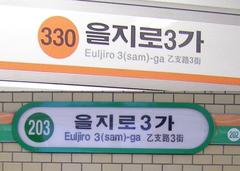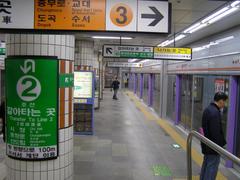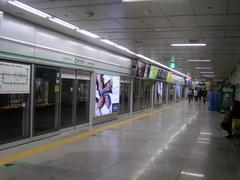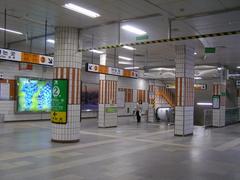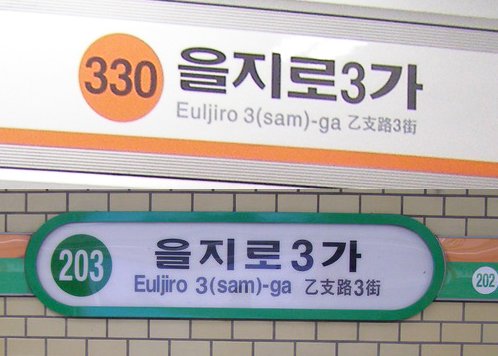
Euljiro 3-Ga Station Visiting Hours, Tickets, and Travel Guide in Seoul
Date: 14/06/2025
Introduction
Euljiro 3-Ga Station, located at the intersection of Seoul Subway Lines 2 and 3, is more than just a transit hub—it stands as a vibrant entryway into one of Seoul’s most dynamic and historically rich neighborhoods. Known for its evolution from a Joseon-era administrative center to an industrial powerhouse and, more recently, to a creative hotspot dubbed “Hipjiro,” the area offers visitors an authentic cross-section of Seoul’s past, present, and future. This detailed guide provides essential visitor information including operating hours, ticketing, accessibility, nearby attractions, travel tips, and the unique cultural fabric that makes Euljiro 3-Ga an essential stop for any traveler.
Table of Contents
- Introduction
- Historical Background of Euljiro and Euljiro 3-Ga Station
- Visitor Information
- Exploring Euljiro: Culture, Cafés, and Nightlife
- Nearby Attractions
- Travel Tips and Accessibility
- Frequently Asked Questions (FAQ)
- Visual Highlights
- Conclusion and Further Engagement
- References
Historical Background of Euljiro and Euljiro 3-Ga Station
From Copper Road to Industrial Hub
Euljiro’s history stretches back to the Joseon Dynasty, when it was known as Gurigae or “Copper Road,” an area marked by government offices and hanji (Korean paper) shops that laid the foundation for its later identity as a center of commerce and industry (Creatrip). During the Japanese colonial period, the area underwent urban transformation under the name Kogane-Cho, with industrialization accelerated by the Oriental Development Company (Korea Herald).
Post-Liberation and Industrialization
After Korea’s liberation in 1945, the area was renamed Euljiro in honor of General Eulji Mundeok. The devastation of the Korean War was followed by rapid reconstruction and industrial growth, with the rise of textile, steel, and printing industries—most notably in the famed “Printing Alley” (Shape the Trip). Sewoon Plaza, established in 1968, further cemented Euljiro’s reputation as an industrial and electronics hub (Korea Travel Post).
The Birth of Euljiro 3-Ga Station and Urban Renewal
Euljiro 3-Ga Station opened in 1983 as part of Seoul’s expanding subway system, quickly becoming a pivotal interchange. The area’s modernization continued, but traces of its industrial past remain visible in vintage signage, narrow alleys, and traditional workshops (Wikipedia).
“Hipjiro”: Creative Renaissance
Since the mid-2010s, Euljiro has experienced a creative revival. Young artists and entrepreneurs have repurposed old workshops into stylish cafés, bars, and galleries, fostering Hipjiro’s distinctive blend of “newtro” (new retro) culture. This transformation has revitalized the neighborhood, while sparking discussions on gentrification and heritage preservation (Korea Herald; Seoul Metropolitan Government).
Visitor Information
Operating Hours and Tickets
- Station Hours: Euljiro 3-Ga Station operates daily from approximately 5:30 AM to midnight (Seoul Metro).
- Tickets: Purchase single-ride tickets at vending machines or use a rechargeable T-money card for convenience across all public transport. No separate admission is required to enter the station.
Accessibility
- Facilities: Elevators, escalators, and tactile paving are available for accessibility. Staff assistance is provided during operating hours.
- Navigation: The station connects directly to multiple subway lines (2, 3, and 5), making it a convenient access point from anywhere in Seoul.
Exploring Euljiro: Culture, Cafés, and Nightlife
Industrial Heritage and Urban Exploration
Euljiro’s dense network of hardware stores, printing shops, and vintage workshops reflects its industrial legacy. The juxtaposition of gritty facades with modern establishments draws urban explorers and photographers seeking authentic Seoul backdrops (Shape the Trip).
Hipjiro Cafés and Bar Scene
- Notable Cafés: Many trendy cafés occupy former workshops, preserving industrial interiors and offering hand-roasted coffee (Sond25 Tistory).
- Bars and Nightlife: The area is famed for its “pojangmacha” (street food tents) and Korean pubs, especially in Nogari Alley, where locals enjoy dried pollack and beer at outdoor tables (Sond25 Tistory).
Art Spaces and Events
- Independent galleries and pop-up exhibitions are common, reflecting the neighborhood’s creative energy.
- The district hosts regular art festivals and night markets, particularly in spring and fall (Seoul Metropolitan Government).
Nearby Attractions
- Cheonggyecheon Stream: A tranquil urban stream with walking paths, just steps from the station (Visit Seoul).
- Myeongdong Shopping District: Fashion, cosmetics, and street food a subway stop away.
- Dongdaemun Design Plaza (DDP): A futuristic landmark for design and night markets (DDP Official).
- Gwangjang Market: Traditional Korean food and textiles, a short walk from Euljiro.
- Insadong and Jongno: Nearby for traditional tea houses and historic sites.
Travel Tips and Accessibility
- Best Time to Visit: Late afternoon to evening for nightlife; weekday afternoons for a quieter experience.
- Getting There: Use Euljiro 3-Ga Station (Lines 2, 3, 5). Buses and taxis are also available.
- Walking the Alleys: Wear comfortable shoes; alleys can be narrow and maze-like.
- Accessibility: Most venues are accessible, but some older buildings have limitations. Confirm with specific locations if needed.
Frequently Asked Questions (FAQ)
Q: What are Euljiro 3-Ga Station’s operating hours?
A: Approximately 5:30 AM to midnight daily.
Q: How do I buy subway tickets?
A: Use vending machines or service counters at the station; T-money cards are recommended.
Q: Are there entrance fees for the station or neighborhood?
A: No. Some galleries or workshops may charge admission.
Q: Is the station accessible for people with disabilities?
A: Yes. Elevators, escalators, and tactile paving are provided.
Q: What are the best nearby attractions?
A: Cheonggyecheon Stream, Myeongdong, Dongdaemun Design Plaza, Gwangjang Market, and Insadong.
Visual Highlights
- Euljiro 3-Ga Station Entrance: Modern signage with vibrant street scenes (alt: “Euljiro 3-Ga Station entrance at night with neon signs”)
- Hipjiro Café Interior: Exposed pipes, hand-roasted coffee, vintage furnishings (alt: “Rustic café interior in Euljiro 3-Ga with hand-roasted coffee”)
- Nogari Alley at Night: Bustling atmosphere of locals enjoying drinks and street food (alt: “Nogari Alley at Night”)
- Art Spaces and Galleries: Contemporary exhibitions in repurposed industrial buildings (alt: “Contemporary art exhibition inside Euljiro Art Space”)
Conclusion and Further Engagement
Euljiro 3-Ga Station and its surrounding neighborhood encapsulate the resilience and creativity of Seoul. From its roots as a Joseon-era administrative hub to its thriving industrial marketplace, and now as the energetic “Hipjiro,” Euljiro 3-Ga invites travelers to experience the city’s ongoing cultural renaissance. Whether you’re exploring historic workshops, savoring café culture, or enjoying the nightlife, every visit offers a new layer of discovery.
For up-to-date travel tips, exclusive walking tours, and more, download the Audiala app and follow us on social media. Share your experiences with #AudialaSeoul and join a community of explorers uncovering Seoul’s hidden gems.
References
- Creatrip
- Korea Herald
- Seoul Metropolitan Government
- Shape the Trip
- Korea Travel Post
- Wikipedia
- Sond25 Tistory
- Visit Seoul
- Seoul Metro
- DDP Official
- Korea Tourism Organization
- SeoulKoreaAsia
